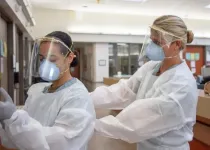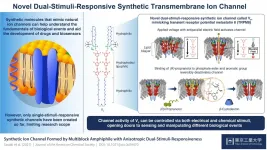(Press-News.org) Obesity and its duration are significant risk factors for type 2 diabetes, cardiovascular events, multiple cancers and decreased quality of life. According to the Centers for Disease Control and Prevention, obesity affects 20.6% of adolescents ages 12-19 in the United States, meaning a potential lifetime of dealing with this condition. Complications from obesity can also result in a potentially decreased life expectancy of five to 20 years for these youth. In a new study published in Pediatrics, researchers at Children's Hospital Colorado (Children's Colorado) have found that both younger and older adolescents have similar weight loss, resolution of high blood pressure and high cholesterol, nutritional impacts and improvement in quality of life after bariatric surgery. These results strongly indicate that, when working with adolescents with severe obesity, age alone should not dissuade providers and patients from pursuing surgery when medically indicated.
"Bariatric surgery has become recognized as the safest and most effective treatment for severe obesity in adults; however, little was known about the relative merits and risks of these procedures in the youngest of teens compared to older adolescents," said Sarah B. Ogle, DO, a surgery fellow at Children's Colorado. "Thus, discussing the option of surgery in young adolescents with intractable severe obesity makes more sense than continuing ineffective treatments, given the proven benefits of surgery. This study is an exciting step toward demonstrating the safety and efficacy of bariatric surgery in the youngest adolescents."
Specifically, the study compared outcomes data of 228 adolescents enrolled in the Teen-Longitudinal Assessment of Bariatric Surgery (Teen-LABS). Each of these patients underwent bariatric surgery. Sixty-six of them were between the ages of 13 and 15 at the time of surgery while 162 of them were between the ages of 16 and 19.
Baseline data were collected within 30 days of surgery. Participants were then evaluated at six months, 12 months, and then annually, for five years after surgery. Researchers compared weight loss, comorbidity resolution, nutritional abnormalities and quality of life between the younger and older adolescents participating in the study.
No significant differences in the remission of high blood pressure or high cholesterol were observed between the age groups. Weight loss and quality of life were similar in the two groups. Further, younger adolescents were less likely to develop elevated transferrin, which plays a central role in iron metabolism, and low vitamin D.
"Younger teens have less commonly been considered eligible for surgery due to their age, but the findings in this analysis should shift the focus from a concern about age to more important factors that should drive decision-making. These include providing the patient with the best opportunity to reach a normal BMI after surgery, reversal of serious complications of obesity, and treatment that will most likely increase the lifespan," said Thomas H. Inge, MD, PhD, Teen-LABS principal investigator, and director of pediatric surgery and the bariatric center at Children's Colorado. "While these results are promising, longer term study of this early intervention is needed to fully evaluate the impact of surgery to reverse late effects of childhood severe obesity that develop over the decades."
INFORMATION:
Teen-LABS was established in 2007 and is the largest and only multicenter, National Institutes of Health (NIH)-sponsored research on adolescent bariatric surgery. This ongoing study involves six clinical centers around the U.S., including Children's Hospital Colorado, Cincinnati Children's Hospital Medical Center, Nationwide Children's Hospital, Texas Children's Hospital, Children's Hospital of Alabama and the University of Pittsburgh Medical Center.
The Teen-LABS consortium is funded by cooperative agreements with the National Institute of Diabetes and Digestive and Kidney Diseases (NIDDK), through grants: UM1DK072493 (PI, Dr. Thomas Inge, University of Colorado, Denver) and UM1DK095710 (PI, Dr. Changchun Xie, University of Cincinnati).
ABOUT CHILDREN'S HOSPITAL COLORADO
Children's Hospital Colorado is one of the nation's leading and most expansive pediatric healthcare systems with a mission to improve the health of children through patient care, education, research and advocacy. Founded in 1908 and recognized as a top 10 children's hospital by U.S. News & World Report, Children's Colorado has established itself as a pioneer in the discovery of innovative and groundbreaking treatments that are shaping the future of pediatric healthcare worldwide. Children's Colorado offers a full spectrum of family-centered care at its urgent, emergency and specialty care locations throughout Colorado, including its location on the Anschutz Medical Campus, and across the region. In 2019, Children's Hospital Colorado, Colorado Springs, opened as the first pediatric-only hospital in southern Colorado. For more information, visit http://www.childrenscolorado.org, or connect with us on Facebook and Twitter.
Children's Hospital Colorado complies with applicable Federal civil rights laws and does not discriminate on the basis of race, color, national origin, age, disability, or sex.
ATENCIÓN: si habla español, tiene a su disposición servicios gratuitos de asistencia lingüística. Llame al 1-720-777-9800.
CHÚ Ý: N?u b?n nói Ti?ng Vi?t, có các d?ch v? h? tr? ngôn ng? mi?n phí dành cho b?n. G?i s? 1-720-777-9800.
http://www.hhs.gov/civil-rights/for-individuals/section-1557
Article Title: "Game theory to enhance stock management of Personal Protective Equipment (PPE) during the COVID-19 outbreak"
Funding: The authors received no specific funding for this work.
Competing Interests: The authors have declared that no competing interests exist.
Article URL: https://journals.plos.org/plosone/article?id=10.1371/journal.pone.0246110
INFORMATION: ...
Decoy protein intercepts spike of coronavirus
Virus prevented from infecting human cells
Protein may be new way to treat and prevent COVID-19
CHICAGO --- Northwestern Medicine scientists have developed a new protein that acts as a trickster to neutralize the COVID-19 infection in a human kidney organoid, a miniature organ made from stem cells in the lab.
The protein is a variant of ACE2 (angiotensin converting enzyme-2), the receptor the coronavirus uses to enter and infect human cells. The modified protein intercepts the S spike of the coronavirus and fools it into binding to it rather than the real ACE2 receptor in cell membranes. ...
NEW YORK, NY (Feb. 1, 2021)--Errors in the way chromosomes are packed into antibody-producing B cells appear to play a role in the development of B cell-related blood cancers, according to a new study by researchers at Columbia University Vagelos College of Physicians and Surgeons.
The findings could lead to new biomarkers for predicting the onset of these cancers and to a new class of cancer therapies that prevent or correct harmful changes in genome architecture.
The study was published online Feb. 1 in the journal Nature Genetics.
Antibodies are made by immune cells called ...
Taking a particular type of medication to treat enlarged prostate is associated with a reduced risk of developing Parkinson's disease, according to a large observational study led by researchers at the University of Iowa, with colleagues in Denmark and China.
The findings, published Feb. 1 in JAMA Neurology, provide compelling evidence that terazosin, and similar medications, might have the potential to prevent or delay the development of Parkinson's disease.
The new study used data on almost 300,000 older men from two large, independent patient datasets--the Truven ...
A new kind of wearable health device would deliver real-time medical data to those with eye or mouth diseases, according to Huanyu 'Larry' Cheng, Dorothy Quiggle Career Development Professor in the Penn State Department of Engineering Science and Mechanics (ESM).
Cheng recently published a paper in Microsystems & Nanoengineering on new micro- and nano-device technology that could revolutionize how certain health conditions are monitored and treated.
"We sought to create a device that collects both small and large substances of biofluids such as tears and saliva, which can be analyzed for certain conditions on a rapid, continuous basis, rather than waiting on test results from samples in a lab," he said.
The sensors would be placed near the tear duct or mouth to collect samples, ...
Winter survival of honey bee colonies is strongly influenced by summer temperatures and precipitation in the prior year, according to Penn State researchers, who said their findings suggest that honey bees have a "goldilocks" preferred range of summer conditions outside of which their probability of surviving the winter falls.
The results of this study, which used several years of survey data provided by the Pennsylvania State Beekeeper's Association and its members, enabled the development of a tool for forecasting honey bee winter survival to support beekeepers' management decisions, the researchers said.
Honey bees contribute more than $20 billion in pollination services to agriculture in the United States and generate another ...
Toxin-antitoxin (TA) systems are now known to negatively control plasmid replication, according to Thomas Wood, Biotechnology Endowed Chair and professor of chemical engineering in the Penn State College of Engineering.
Plasmids, or extra-chromosomal bits of DNA, allow bacteria to evade antibiotics, making the antibiotics ineffective in halting a bacterial infection.
The presence or absence of plasmids impacts a bacterium's resistance to antibiotics and its ability to cause infection -- important points related to fighting bacterial infections, according to Wood.
"Each year, there are at least 700,000 deaths worldwide because of bacterial infections, a growing number that is projected to increase to 10 million by 2050," Wood said. "And of course, the effectiveness ...
February 1, 2021 - Extracorporeal cardiopulmonary resuscitation (ECPR) is a potentially lifesaving treatment for patients in cardiac arrest when the circulation can't be restored by conventional CPR. New guidelines for ECPR in adults and children, developed by the Extracorporeal Life Support Organization (ELSO), are presented by the ASAIO Journal, official journal of the American Society for Artificial Internal Organs. The journal is published in the Lippincott portfolio by Wolters Kluwer.
A specialized application of extracorporeal membrane oxygenation (ECMO), ECPR is increasingly being used to provide a chance ...
Imagine a rubber band that was capable of snapping itself many times over, or a small robot that could jump up a set of stairs propelled by nothing more than its own energy. Researchers at the University of Massachusetts Amherst have discovered how to make materials that snap and reset themselves, only relying upon energy flow from their environment. The discovery may prove useful for various industries that want to source movement sustainably, from toys to robotics, and is expected to further inform our understanding of how the natural world fuels some types of movement.
Al Crosby, a professor of polymer science and engineering in the College of Natural Sciences at UMass Amherst, ...
A key thread that holds together the delicate balance of a complex biological system is the transmembrane ion channel. These are supramolecular, or multi-molecule, ion and molecule exchange routes embedded within cell membranes to ensure essential chemical transport to and from the cell and facilitate cell signaling.
In recent years, synthetic biomolecules that mimic the structures and functions of natural ion channels have garnered much interest among molecular biology researchers as models for studying the fundamentals of these channels and perhaps, even creating drug alternatives or developing advanced biosensors.
However, although ...



